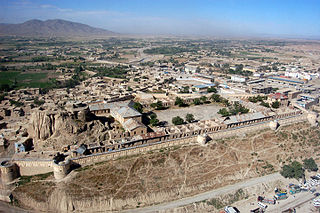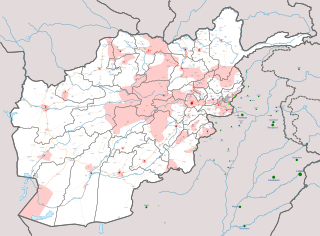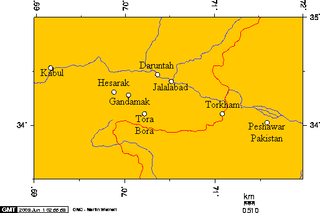
Paktia is one of the 34 provinces of Afghanistan, located in the east of the country. Forming part of the larger Loya Paktia region, Paktia Province is divided into thirteen districts and has a population of roughly 525,000, which is mostly a tribal society living in rural areas. Pashtuns make up the majority of the population but smaller number of Tajiks are also found. Gardez is the provincial capital.

Paktika is one of the 34 provinces of Afghanistan, located in the eastern part of the country. Forming part of the larger Loya Paktia region, Paktika has a population of about 413,800, mostly ethnic Pashtuns. The town of Sharana serves as the provincial capital, while the most populous city is Urgun.

The Taliban insurgency began after the group's fall from power during the 2001 War in Afghanistan. The Taliban forces are fighting against the Afghan government, formerly led by President Hamid Karzai, now led by President Ashraf Ghani, and against the US-led International Security Assistance Force (ISAF). The insurgency has spread to some degree over the Durand Line border to neighboring Pakistan, in particular the Waziristan region and Khyber Pakhtunkhwa. The Taliban conduct low-intensity warfare against Afghan National Security Forces and their NATO allies, as well as against civilian targets. Regional countries, particularly Pakistan, Iran, China and Russia, are often accused of funding and supporting the insurgent groups.

Since 1949, a series of occasional armed skirmishes and firefights have occurred along the Durand Line between the Afghan National Security Forces and the Pakistan Armed Forces. The latest hostilities, which are ongoing, began with the overthrow of the Taliban government.

The following items form a partial timeline of the War in Afghanistan. For events prior to October 7, 2001, see 2001 in Afghanistan
The Haqqani network is an Afghan guerrilla insurgent group using asymmetric warfare to fight against US-led NATO forces and the government of Afghanistan. Maulvi Jalaluddin Haqqani and his son Sirajuddin Haqqani have led the group. It is an offshoot of the Taliban.

Dand Aw Patan District is a district of Paktia Province, Afghanistan. The district is within the heartland of the Mangal tribe of Pashtuns. It lies on the Durand Line border with the Kurram District of Pakistan's Khyber Pakhtunkhwa.

Operation Zarb-e-Azb was a joint military Defensive conducted by the Pakistan Armed Forces against various militant groups, including the Tehrik-i-Taliban Pakistan (TTP), the Islamic Movement of Uzbekistan, the East Turkestan Islamic Movement, Lashkar-e-Jhangvi, al-Qaeda, Jundallah and the Haqqani network. The operation was launched on 15 June 2014 in North Waziristan along the Pakistan-Afghanistan border as a renewed effort against militancy in the wake of the 8 June attack on Jinnah International Airport in Karachi, for which the TTP and the IMU claimed responsibility. As of 14 July 2014, the operation internally displaced about 929,859 people belonging to 80,302 families from North Waziristan.

The Battle of Kunduz took place from April to October 2015 for control of the city of Kunduz, located in northern Afghanistan, with Taliban fighters attempting to seize the city and displace Afghan security forces. On 28 September 2015, the Taliban forces suddenly overran the city, with government forces retreating outside the city. The capture marked the first time since 2001 that the Taliban had taken control of a major city in Afghanistan. The Afghan government claimed to have largely recaptured Kunduz by 1 October 2015 in a counterattack, although local sources in the city disputed the claim made by government officials.

The Islamic State of Iraq and the Levant – Khorasan Province is a branch of the militant Islamist group Islamic State of Iraq and the Levant (ISIL) active in South Asia and Central Asia. Some media sources also use the terms ISK, ISISK, IS-KP, ISIS-K, or Daesh-Khorasan in referring to the group. The Khorasan group's main activity is in the border region of eastern Afghanistan and northern Pakistan, but its area of operations also includes other parts such as Tajikistan, and India where individuals have pledged allegiance to it.
The following lists events that happened during 2016 in Afghanistan.

Operation Omari, also called the Spring Offensive, is an offensive launched by the Taliban against the Afghan government in Afghanistan. Its start was announced on 12 April 2016. The Taliban made their yearly spring offensive announcement on April 12, 2016. They named the offensive in honor of the movement's late leader. The announcement of Operation Omari includes details on how the members of the group should present themselves in public. The aim of the Operation is considered ambitious and its focus is on clearing the remaining areas from enemy control and presence. Unlike offensive announcements from previous years this announcement contained details about specific targets that would be attacked during the operation. The targets were stated in general terms with reference only to "large scale attacks on enemy positions across the country, martyrdom-seeking and tactical attacks against enemy strongholds, and assassination of enemy commanders in urban centers."
Events in the year 2017 in Afghanistan.
The town of Sangin, in Helmand Province, Afghanistan, was captured by the Taliban on 23 March 2017. For two months, the Taliban had launched fresh attacks in trying to recapture the town.

The Battle of Tora Bora in June 2017 was a military engagement for the cave complex of Tora Bora and its surroundings in Afghanistan. Fighting took place between the Islamic State of Iraq and the Levant – Khorasan Province (ISIL-K) and forces opposed to it, namely the Taliban, militias formed by the population of the Pachir Aw Agam District, and the Afghan National Army. After heavy clashes ISIL-K forces initially succeeded in capturing Tora Bora from the Taliban on 13–14 June 2017, but Afghan government forces retook the cave complex by 17 June.

The Ghazni offensive began on 10 August 2018, when Taliban fighters launched an assault on the city of Ghazni, Afghanistan's sixth largest city and one which has been culturally and strategically important for much of the country's history. The attack resulted in the deaths of hundreds of insurgents, soldiers, police, and civilians. The city also sustained large-scale property damage. The battle, occurring only weeks before Afghanistan's 2018 parliamentary election, was the largest since a three-day truce in June had raised hopes of peace talks.
This article summarizes the history of the War in Afghanistan (2001–present). It currently runs through 2020. For more recent information see the main article on that war.
Events from the year 2020 in Afghanistan.











